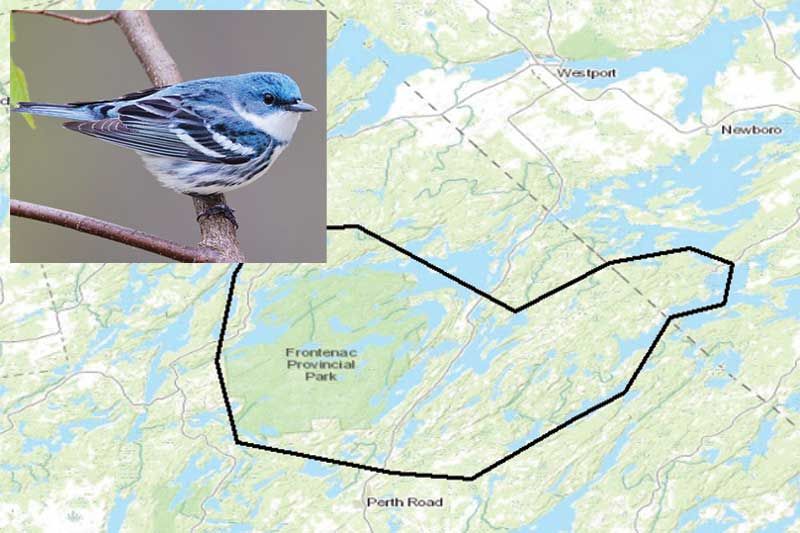Jeff Green | Dec 02, 2015
Frontenac Park and the surrounding area, including the Elbow Lake Environmental Education Centre (EEEC), are in the process of being designated an Important Bird Area (IBA) because they are the summer home to 400 to 500 pairs of Cerulean Warblers, the largest concentration of the blue birds in Canada.
According to the profile of the warbler on the Government of Canada Species at Risk registry, there are between 500 and 1000 nesting pairs of Ceruleans in Canada, which underscores how important the Frontenac County population is.
Ceruleans are a small bird shaped much like the common Chickadee. Their total body length is 10 to 12.5 centimetres and they weigh 8 to 10 grams. The males are a deep blue colour with a blue-black band across the throat, and the bird gets its name from the coloration of the male. Females are blue-green, with yellow-white eyebrows.
Ceruleans winter in a narrow range in the foothills of the Andes in Columbia and Ecuador, and scatter in the summer through the Eastern seabord of the United States, with southern Ontario and Quebec being the north end of their range.
Deciduous forests with rich undergrowth and mixed hardwoods such as Hemlock, Oak, and Maple are the ideal summer habitat for them. They tend to nest high up in hidden nooks on the tallest trees in the forest.
The major threat to the Cerulean, and other warblers, is habitat loss in their wintering grounds.
In Canada, the major concern is maintaining large tracts of forests and minimizing the amount of fragmentation in the forest cover because Ceruleans are more vulnerable in forest edge habitat.
Mike Burrell is the Important Bird Areas (IBA) co-ordinator with Bird Studies Canada, a national organization based at Long Point on Lake Erie. He works, however, out of his home near Sunbury, and made a presentation to the Frontenac Stewardship Council Environmental Forum in Verona on Thursday, November 26.
“The designation of Frontenac Park and the Elbow Lake Environmental Centre as an IBA comes about as the result of the efforts of a number of groups and individuals,” he said, when interviewed later over the phone. “Among those are Steve Lougheed at Queens; the Frontenac Bird Studies, a group led by Dan Darbyshire that studies bird populations in the Frontenac Arch area; the staff at Frontenac Park; and others”.
Ever since the Cerulean warbler was updated from a 'species of concern' to an 'endangered species' in 2011, efforts have been made to determine how many and how widespread they are in Frontenac County. There used to be a population in south-western Ontario, but a lack of uninterrupted forest cover has decimated that population, and according to the Canadian Bird Atlas the species has been declining by a rate of 17% per decade since the 1960s.
Since 2011, local groups have been working to determine how plentiful the warblers are in Frontenac County.
“They are a small bird, and they nest high up in the trees, so the best way to identify them, as with most birds, is by their song. Each warbler has a distinctive song, and it does not take too long for someone to learn how to identify the Ceruleans’ song,” said Steve Burrell.
By listening at intervals, it is possible to determine the location of a range for a nesting pair, and by tracking this information over time, Burrell said that researchers are able to determine the number of nesting pairs in a region with confidence.
Among the impacts of determining an IBA for Cerulean Warblers, aside from suggesting ways to ensure the continued viability of species in the area, are the educational and public relations potential.
“It shows how the habitat in the Frontenac Arch is rich in ways that we are only learning about over time,” said Burrell, “And helps to highlight all the species that depend on the habitat in the arch, particularly in protected areas such as Frontenac Park and Elbow Lake.”
According to COSEWIC (the Committee on the Status of Endangered Wildlife in Canada) the government body responsible for designating species at risk, the future prospects for the Cerulean Warbler in Canada are not bright.
“The Canadian population is estimated to be 433-543 pairs (866-1086 mature individuals), most of which are found in the Frontenac Axis region of south-eastern Ontario ... In Quebec, Cerulean Warblers have disappeared from five of six known sites occupied since the 1960s. Overall, the Canadian population has declined by at least 16% over the past 10 years. The potential for rescue is believed to be low, owing to ongoing population declines in the U.S.,” said COSEWIC in 2010.
The fact there are 800-1000 Ceruleans in Frontenac County five years later, and the IBA designation, may give hope that the warbler population will be maintained in southern Canada for some time to come.
More Stories
- No Winner Yet in Catch The Ace But Fundraising Target Met
- South Frontenac Food Bank Opens Second Location in Battersea
- Sharbot Lake Pentecostal Church Anniversary - 1925-2025
- Frontenac Holistic Health Fair - September 20 At Storrington Centre
- Odd Year For Real Estate - But Sales Are Steady Year Over Year
- 193rd Kingston Fall Fair
- Kim Phuc - the Napalm Girl - To Visit Flinton In November
- South Frontenac Council - September 2
- Sticker Shock - EV Charging Station To Cost North Frontenac Township
- 30th Anniversary Verona Car Show

